These Are the Employee Wellness Ideas That Job Seekers Really Want
A recent report found that employee burnout is responsible for up to half of all employee attrition. To combat burnout and employee sickness rates, companies have instigated employee wellness programs.
Yet, 60% of employees are still not taking part. Why? Because there’s often not enough employee buy-in when conceiving employee wellness ideas.
In a climate where hiring and retaining qualified employees is harder than ever (unemployment rates continue to flicker at around 4%), companies need to offer candidates more than just a salary—they need to provide an employee experience. Businesses that provide attractive and well-thought-out employee wellness programs will be at a significant advantage in attracting top candidates and retaining talented employees.
Employee wellness programs that are geared only towards the company’s benefit are likely to fail and cost the business more than they originally invested in the programs. We surveyed over 200 job seekers who are seeking full-time employment to find out which employee wellness ideas make them tick and what motivates them to participate—here’s what we found.
Key takeaways:
Job seekers value companies that offer employee wellness programs: A combined 61% of job seekers say that it’s either very or moderately important to them that prospective employers offer employee wellness programs. [Read more]
Job seekers are overlooking employers that don’t offer employee wellness programs: Almost 40% of job seekers say that the absence of employee wellness programs has been either the main reason or one of the reasons why they’ve previously declined job offers. [Read more]
Job seekers are more likely to participate in certain types of programs over others: Regular health screenings and physical activities are the most popular types, while smoking cessation and lifestyle coaching programs are among the least desired. [Read more]
Programs that take place outside of working hours are likely to see higher participation rates: 42% of job seekers prefer to take part in employee wellness programs after work, and 20% prefer to participate before work. Just 32% prefer to take part during their lunchtimes. [Read more]
Paid time off is the most popular incentive for participating in wellness programs: 42% of job seekers say that paid time off increases the likeliness of them participating in wellness programs. [Read more]
Job seekers value companies that offer employee wellness programs
When asked how important it is to them that the company they’re considering applying to offers employee wellness programs, a combined 61% of job seekers say that it’s either very or moderately important.
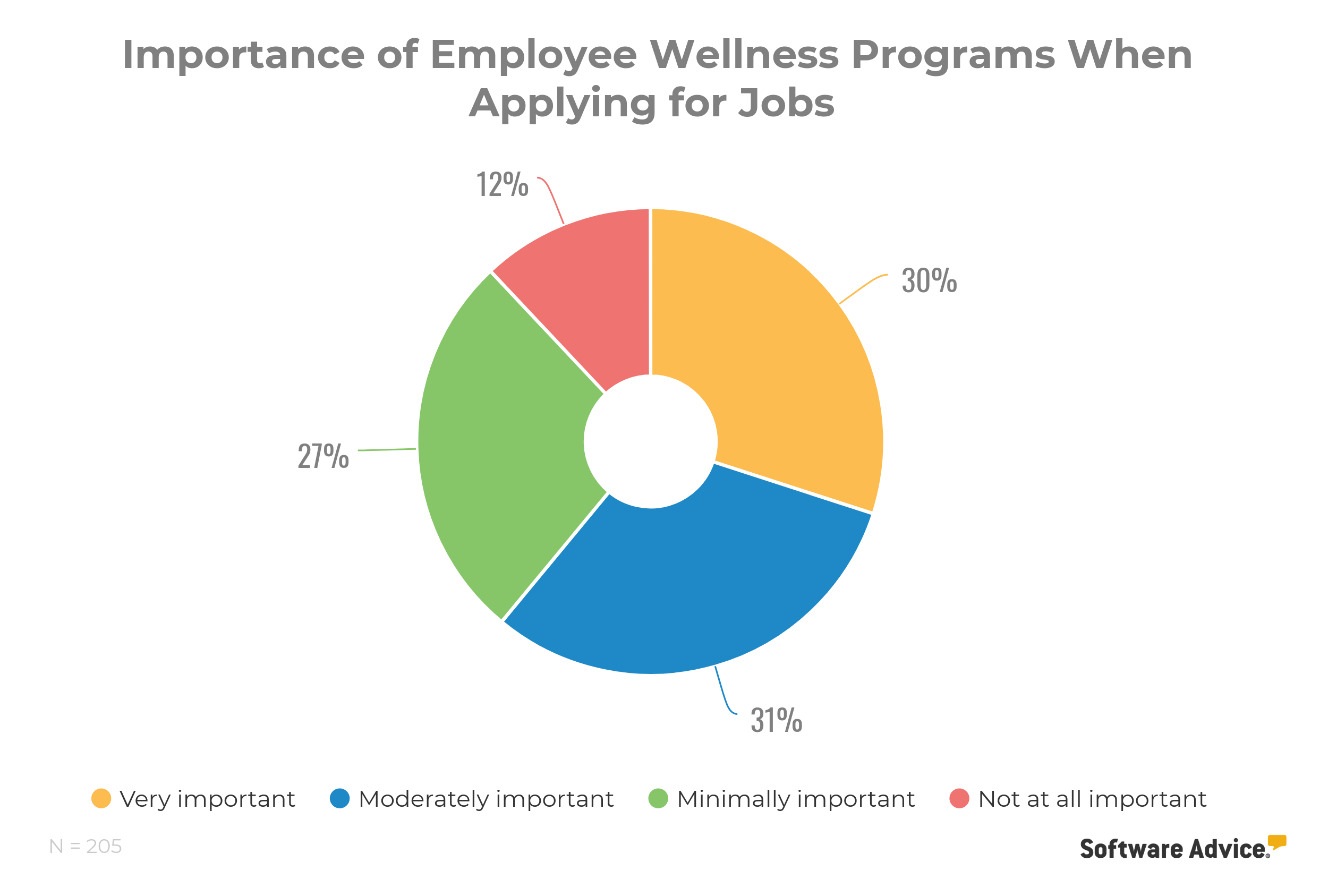
What this tells us: Job seekers value more than just a salary. If over 60% of job seekers say that employee wellness programs are important to them when considering whether to apply to a company, this means that they’re actively looking for evidence of wellness programs during their job searches.
While this doesn’t necessarily mean that a lack of employee wellness programs will prevent them from applying to a role altogether (although, hold tight for the next section of this report), it does show that job seekers value employee wellness programs and the companies that offer them.
Bottom line: The employee wellness options you offer could be the clincher between a candidate opting to apply to you rather than one of your competitors.
Takeaway: If you’re not already running employee wellness programs, or don’t advertise your wellness programs on your job postings, you’re automatically setting off alarm bells for many job seekers. Nowadays, candidates are interested in the other qualities a company has to offer that contribute to a more holistic sense of job satisfaction.
Start thinking about what employee wellness ideas your company could offer, or, if you already offer them, make sure they’re highlighted within your job postings and career pages.
Job seekers are overlooking employers that don’t offer employee wellness programs
Our survey found that 37% of job seekers have turned down a job offer either primarily or partially due to the absence of a company’s employee wellness programs.
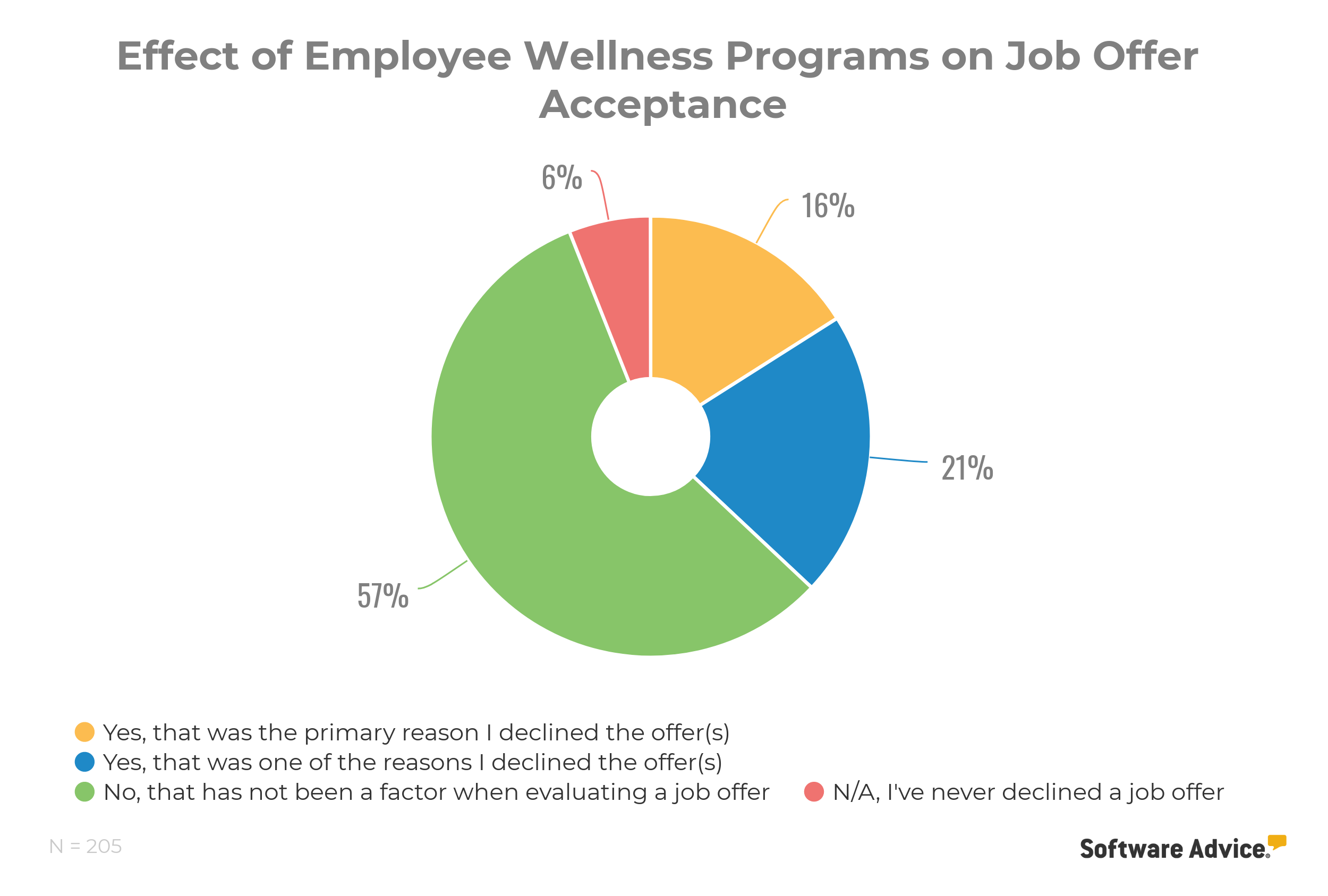
What this tells us: Candidates aren’t afraid to decline your offer during the final stages of hiring if they feel like their expectations haven’t been met. While sufficient financial compensation is an important requisite for candidates, job seekers are also placing value on company wellness initiatives and perks.
By not making your employee wellness program options explicit during the recruitment process (or not having employee wellness options at all), you’re risking wasting a significant amount of company money and time on trying to hire candidates who are actively seeking wellness initiatives from their employer. Likewise, by not offering employee wellness options, you’re risking not attracting quality candidates in the first place.
Takeaway: Recruiters need to ensure that candidates are clear on what employee wellness options your company offers. Though you may not think that a company perk could be so decisive for candidates accepting job offers, it’s clear that job seekers are willing to sacrifice a position if a company doesn’t offer sufficient wellness options.
Job seekers are more likely to participate in certain types of programs over others
We asked job seekers how likely they were to participate in several types of employee wellness programs if an employer offered them.
The most popular types of programs where job seekers say they’re very or moderately likely to participate are:
Regular health screenings (a combined 73% of respondents)
Physical activities (a combined 63% of respondents)
Stress management programs (a combined 58% of respondents)
The least popular types of programs where job seekers say they’re minimally likely or not likely at all to participate are:
Smoking cessation programs (a combined 73% of respondents)
Lifestyle coaching (a combined 56% of respondents)
Weight management programs (a combined 53% of respondents)
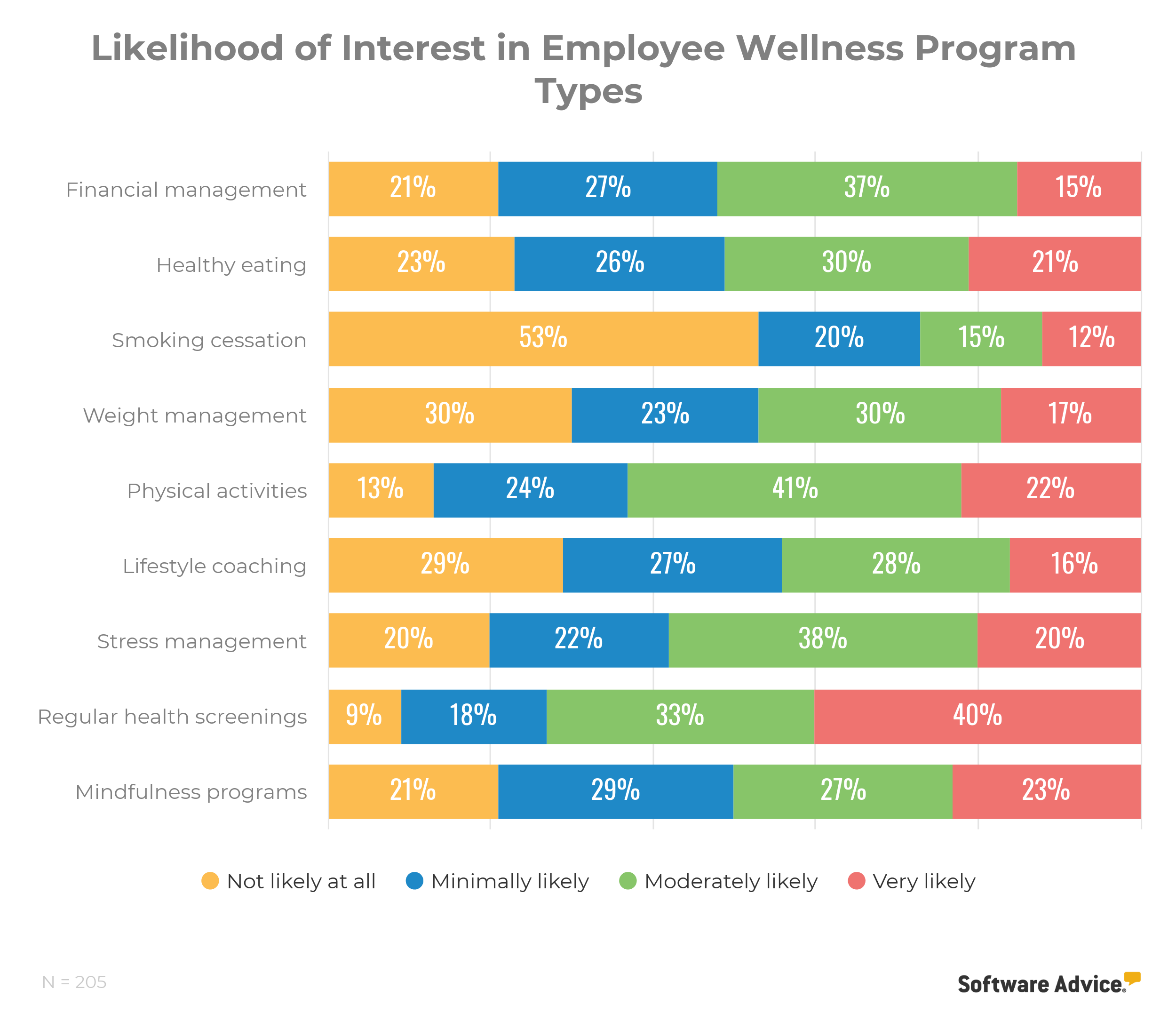
What this tells us: While this largely comes down to personal preferences, it’s clear that certain types of programs are likely to see higher participation rates than others. In reality, high program participation rates come down to how well the company has listened to what its workforce wants.
For example, offering smoking cessation programs to a workforce where a small percentage of employees are smokers won’t attract large numbers of participants. However, if you were to provide a holistic program that offered a range of wellbeing-focused initiatives (e.g., various physical activities, stress management, and smoking cessation programs) where an employee could pick and choose, you may see a higher take-up rate.
The fact that our survey shows that interest in stress management and financial management programs is also high shows that job seekers are looking for less focus on programs aimed towards physical wellbeing. Programs that are aimed at mental, emotional, and financial wellbeing are also in demand.
Takeaway: It’s time to throw away the cookie cutter. Listening to your employees’ wellness ideas is the best way of creating successful wellness programs that truly fit their needs, and in turn see the business benefits of a healthier and more engaged staff.
Use employee pulse survey tools to gain insight into your employees’ employee wellness ideas, and ask for evaluations regularly to ensure that your program(s) can succeed.
Programs that take place outside of working hours are likely to see higher participation rates
When asked to choose a time preference for employee wellness programs, 42% of job seekers say they prefer after-work programs, 30% prefer programs to take place during lunchtime, and 20% prefer programs to take place before work.
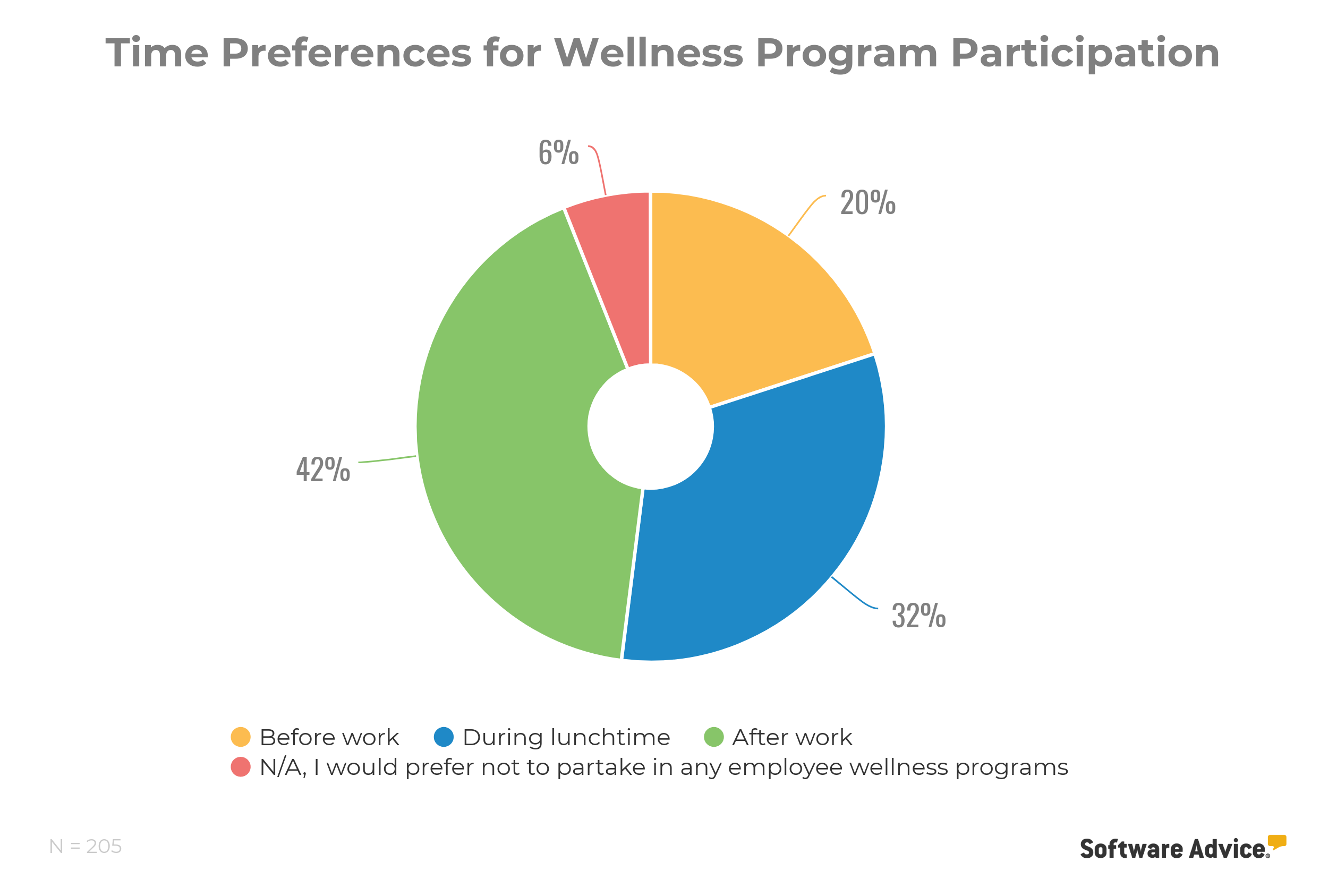
What this tells us: The time you designate for your employee wellness programs to take place could hurt participation rates. These results could also indicate that depending on what type of wellness programs you run, your employees may feel more comfortable taking part in them during a certain time of the day.
For example, if you run exercise classes but don’t have employee-accessible showers, some employees may not feel compelled to participate during working hours. Programs that don’t require employees to leave the office may be better run during working hours.
Takeaway: Consider what time of day works best for your employees with the different types of wellness programs you’re offering—or better yet, ask them. It’s crucial that your employees have buy-in to your wellness programs, and that they’re tailored to their needs.
Paid time off is the most popular incentive for participating in wellness programs
We asked job seekers which incentive would most increase their likelihood to participate in employee wellness activities. With 42%, the most popular incentive is paid time off, followed by gift cards (21%) and discounted access to services such as gym memberships (15%).
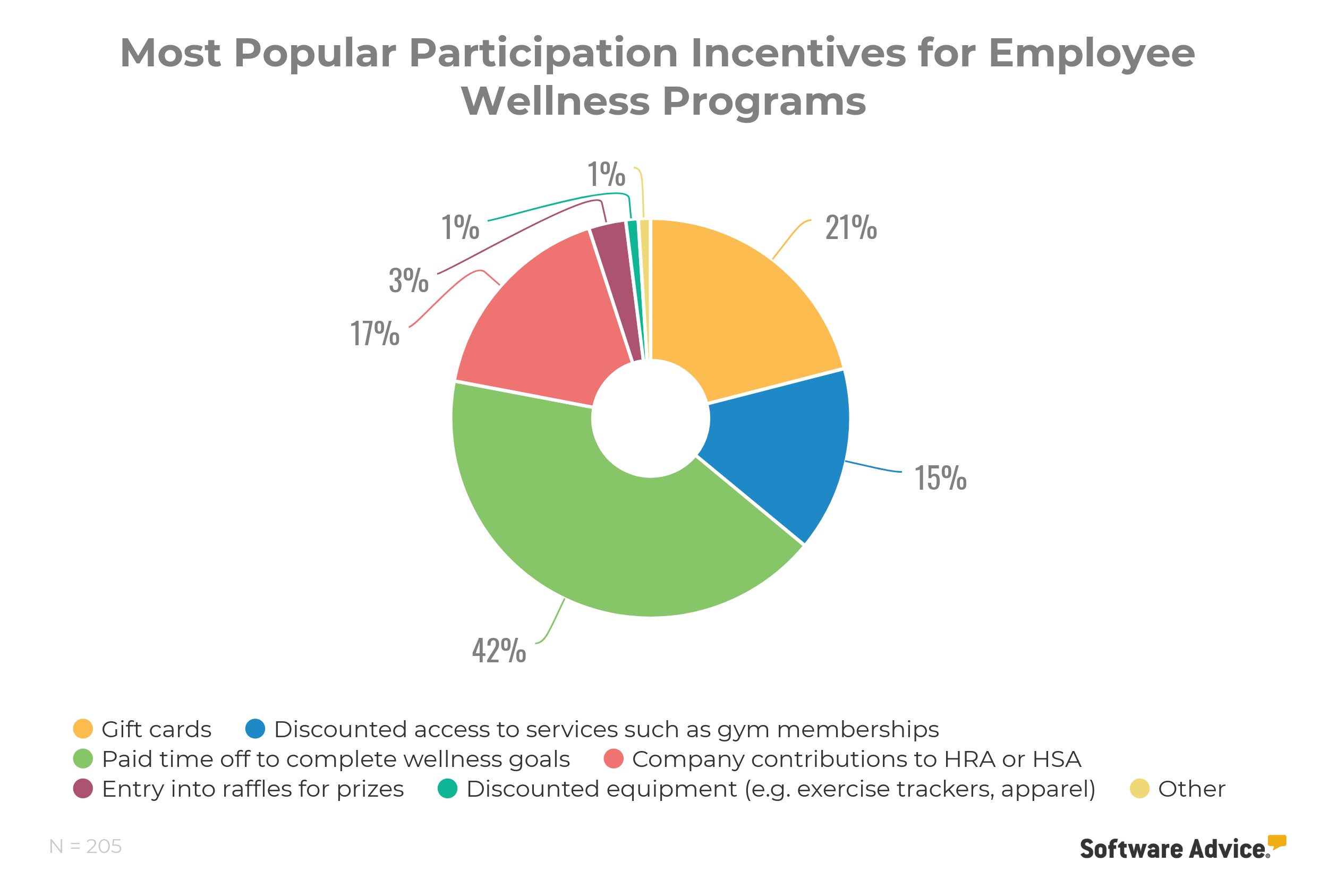
What this tells us: Paid time off is a non-cash incentive that would motivate the majority of job seekers to participate in employee wellness programs. This indicates that cash incentives to motivate participation, which are likely small in value, are less meaningful for employees than access to more time off work. This makes sense, given that the average American worker only has 10 days of vacation per year, not including sick days or paid holiday leave.
Only 17% of job seekers say that HRA or HSA contributions are their preferred incentive for employee wellness participation, which shows that job seekers are now less driven by contributions to medical expenses or medical reimbursements.
Takeaway: In order to have a true work-life balance, time off is crucial for employees. Paying your employees to take time off can help prevent employee burnout episodes by allowing them time to reenergize and relax. However, all employees will be motivated by different incentives, and so having multiple reward options for your employees should be a best practice you put in place.
Bottom line: Employee wellness ideas need to be staff-driven
Employee wellness programs are wasted money if they’re not benefitting you and your employees. As our survey shows, employee wellness programs are not only important to job seekers, but what and how a company offers them is important, too. Not just this, but job seekers are actively evaluating employers on the basis of whether they offer wellness programs at all.
But, cookie cutter wellness programs are not the answer. Companies cannot expect to run a biweekly yoga class and expect employees to value this as an investment in their wellbeing. Job seekers want a holistic take on the traditional wellbeing program that employers so often implement.
The shift from the importance of physical wellbeing programs to those that cater to all facets of wellbeing, such as financial, stress, and mental health should be driving employers to think more comprehensively about the wellness initiatives they offer. However, more importantly, asking employees what they truly want from wellness programs will significantly improve participation rates
Methodology
To collect data for this research report, we conducted an online survey of 205 Americans in April 2019. Responses came from a random sample of the U.S. population. We screened our sample to only include respondents who fit the specified criteria. In this case, respondents were screened to ensure they were currently seeking full-time employment.